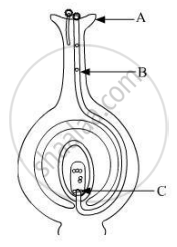Advertisements
Advertisements
प्रश्न
Identify the odd. Stigma, Style, Pollen, Ovary.
उत्तर
Pollen (Remaining are parts of gynaecium)
APPEARS IN
संबंधित प्रश्न
A student was asked to observe and identify the various parts of an embryo of a red kidney bean seed. He identified the parts and listed them as under:
I. Tegmen
II. Testa
III. Cotyledon
IV. Radicle
V. Plumule
The correctly identified parts among these are
(A) I, II and III
(B) II, III and IV
(C) III, IV and V
(D) I, III, IV and V
Name the parts A, B and C shown in the diagram and write their functions.

Name the parts labelled as A, B, C and D in the diagram given below:-

In the following diagram showing the structure of embryo of a dicot seed, what are the parts marked I, II and III sequentially?

A flower may have either male or female reproductive parts. Such a flower is called ______.
The reproductive part of a plant is the ______.
Where are a plant's sex organs located?
Fill in the following blank with suitable word :
The ovule becomes a .......... after fertilisation.
Draw a neat sketch of the stamen of a flower. Mark in it filament and anther.
Draw a neat sketch of the carpel of a flower. Mark in it stigma, style and ovary.
What is made in anther of a flower?
What is seed? What are the parts of a seed? Explain with the help of a labelled diagram.
What is meant by 'unisexual flowers' and 'bisexual flowers'? Give two examples of each.
Which among the following statements are true for unisexual flowers?
(i) They possess both stamen and pistil
(ii) They possess either stamen or pistil
(iii) They exhibit cross pollination
(iv) Unisexual flower possessing only stamens cannot produce fruits
(a) (i) and (iv)
(b) (ii), (iii) and (iv)
(c) (ii) and (iii)
(d) (i), (iii) and (iv)
Which of the following statements are true for sexual reproduction in flowering plants?
(i) it requires two types of gametes
(ii) fertilisation is a compulsory event
(iii) it always results in the formation of zygote
(iv) offsprings formed are clones
(a) (i) and (iv)
(b) (i), (ii) and (iv)
(c) (i), (ii) and (iii)
(d) (ii), (iii) and (iv)
Mention the function of Anther.
What part is played by stamens and carpels in reproduction?
A student is asked to study the different parts of an embryo of pea seeds. Given below are the essential steps for the experiment :
(I) Soak the pea seeds in plain water and keep them overnight.
(II) Cut open the soaked seed and observe its different parts.
(III) Take some pea seeds in a petri dish.
(IV) Drain the excess water. Cover the seeds with a wet cotton cloth and leave them as it is for a day.
The correct sequence of these steps is
(A) III, I, IV, II
(B) III, IV, I, II
(C) III, I, II, IV
(D) III, II, I, IV
Distinguish between unisexual and bisexual flowers giving one example of each. Draw a diagram showing process of germination of pollen grains on stigma and label the following parts:
(a) Female germ cell
(b) Male germ cell
(c) Ovary
Draw a diagram of the longitudinal section of a flower and label on it sepal, petal, ovary and stigma.
Fill in the blank by selecting suitable word:
Transfer of pollen grains from the anther to the stigma is known as______________.
Fill in the blanks and rewrite the completed statements:
Lymph flows in _______________ direction.
Draw a diagram of the longitudinal section of a flower and label the following parts.
Differentiate between self-pollination and cross-pollination.
Find an odd one out.
Calyx : Sepals : : Corolla : ________________
Pollen grains from anther are transferred to the stigma.
Define.
Inflorescence
Identify the female gametophyte in angiosperms.
Pineapple fruit develops from ______.
The seed that contains the future plant is called the ______
The process of release of eggs from the ovary is called ______
Variations occur as a result of ______
Length of pollen tube depends on the distance between ______
Give reason for the following:
Fertilization cannot take place in flowers if pollination does not occur.
Type of sexual reproduction is ______.
